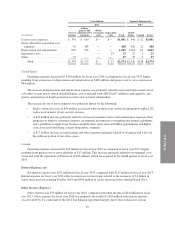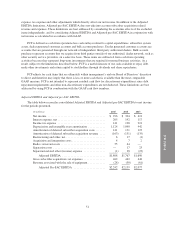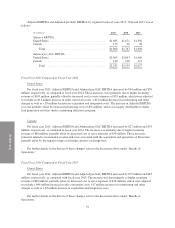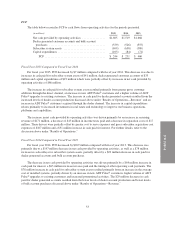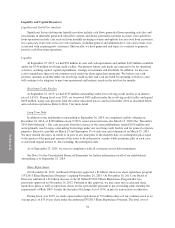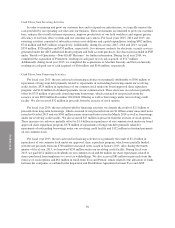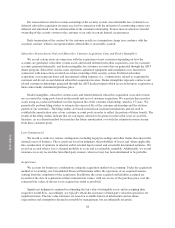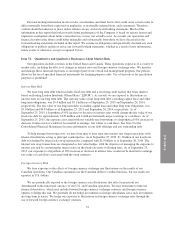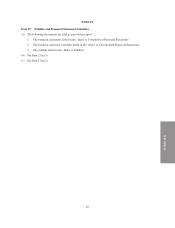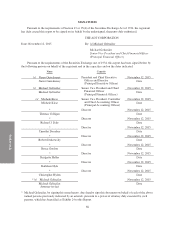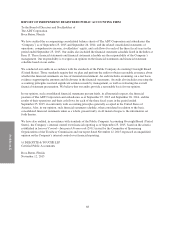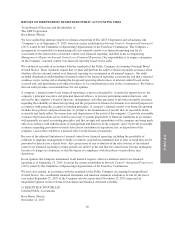ADT 2015 Annual Report Download - page 133
Download and view the complete annual report
Please find page 133 of the 2015 ADT annual report below. You can navigate through the pages in the report by either clicking on the pages listed below, or by using the keyword search tool below to find specific information within the annual report.
FORM 10-K
Goodwill
We assess goodwill for impairment annually or more frequently if events or changes in business
circumstances indicate that it is more likely than not that the carrying value of a reporting unit exceeds its fair
value. In performing these assessments, management relies on various factors, including operating results,
business plans, economic projections, anticipated future cash flows and other market data. There are inherent
uncertainties related to these factors and judgment is required in applying them to the goodwill impairment test.
We perform our annual impairment test for goodwill, by reporting unit, as of the first day of our fourth fiscal
quarter of each year.
Fair value determinations require considerable judgment and are sensitive to changes in underlying
assumptions and factors. As a result, there can be no assurance that the estimates and assumptions made for
purposes of the annual goodwill impairment test will prove to be accurate predictions of the future. Examples of
events or circumstances that could reasonably be expected to negatively affect the underlying key assumptions,
and ultimately impact the estimated fair value of the business may include such items as: a prolonged downturn
in the business environment (i.e., sales volumes and prices), changes in economic conditions that significantly
differ from our assumptions in timing or degree, volatility in equity and debt markets resulting in higher discount
rates, and unexpected regulatory changes.
As discussed in Note 1 to the Consolidated Financial Statements, effective for the fourth quarter of fiscal
year 2015, we changed our operating segment reporting structure. Under this new structure, we now have two
operating segments, which are also our reporting units, as this is the lowest level for which discrete financial
information is available and the level at which segment management regularly reviews the operating results. As a
result of this change, we reallocated goodwill to the new reporting units using the relative fair value approach. As
part of our fiscal year 2015 annual goodwill impairment test, we have elected to perform a quantitative goodwill
impairment test for both of our reporting units applying the traditional two-step approach. The fair value for each
reporting unit was determined using a discounted cash flow method. Key assumptions for computing fair value
included discount rate, long term growth rate, foreign currency exchange rate, and cash flow projections for each
of our reporting units. Based on the results of our step one testing, the fair values of each of our reporting units
sufficiently exceeded their carrying values. Therefore, step two of the goodwill impairment test was not required
and no goodwill impairment was recognized for fiscal year 2015.
While our goodwill impairment test resulted in fair values of goodwill in excess of carrying values, if our
assumptions are not realized, it is possible that in the future an impairment charge may need to be recorded.
However, it is not possible at this time to determine whether an impairment charge would result or if such a
charge would be material. We will continue to monitor the recoverability of our goodwill.
Long-Lived Assets
We review long lived assets held and used by us, including property and equipment and amortizable
intangible assets, for impairment whenever events or changes in business circumstances indicate that the carrying
amount of the asset group may not be fully recoverable. If an impairment is determined to exist, we calculate any
related impairment loss based on the difference between the fair value and carrying values of the respective
assets.
Impairments on long-lived assets to be disposed of are determined based upon the fair value less cost to sell
of the applicable assets. The calculation of the fair value of long-lived assets is based on assumptions concerning
the amount and timing of estimated future cash flows and assumed discount rates, reflecting varying degrees of
perceived risk. There were no material long-lived asset impairments in fiscal years 2015, 2014 and 2013.
Income Taxes
For purposes of our Consolidated Financial Statements as of September 25, 2015 and September 26, 2014,
income tax expense, deferred tax balances and tax carryforwards are recorded on a consolidated return basis for
59


